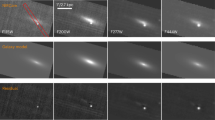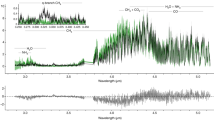Abstract
Short-duration γ-ray bursts are intense flashes of cosmic γ-rays, lasting less than about two seconds, whose origin is unclear1,2. The favoured hypothesis is that they are produced by a relativistic jet created by the merger of two compact stellar objects (specifically two neutron stars or a neutron star and a black hole). This is supported by indirect evidence such as the properties of their host galaxies3, but unambiguous confirmation of the model is still lacking. Mergers of this kind are also expected to create significant quantities of neutron-rich radioactive species4,5, whose decay should result in a faint transient, known as a ‘kilonova’, in the days following the burst6,7,8. Indeed, it is speculated that this mechanism may be the predominant source of stable r-process elements in the Universe5,9. Recent calculations suggest that much of the kilonova energy should appear in the near-infrared spectral range, because of the high optical opacity created by these heavy r-process elements10,11,12,13. Here we report optical and near-infrared observations that provide strong evidence for such an event accompanying the short-duration γ-ray burst GRB 130603B. If this, the simplest interpretation of the data, is correct, then it confirms that compact-object mergers are the progenitors of short-duration γ-ray bursts and the sites of significant production of r-process elements. It also suggests that kilonovae offer an alternative, unbeamed electromagnetic signature of the most promising sources for direct detection of gravitational waves.
This is a preview of subscription content, access via your institution
Access options
Subscribe to this journal
Receive 51 print issues and online access
$199.00 per year
only $3.90 per issue
Buy this article
- Purchase on Springer Link
- Instant access to full article PDF
Prices may be subject to local taxes which are calculated during checkout


Similar content being viewed by others
References
Nakar, E. Short-hard gamma-ray bursts. Phys. Rep. 442, 166–236 (2007)
Lee, W. H. & Ramirez-Ruiz, E. The progenitors of short gamma-ray bursts. New J. Phys. 9, 17–92 (2007)
Fong, W. et al. Demographics of the galaxies hosting short-duration gamma-ray bursts. Astrophys. J. 769, 56–73 (2013)
Rosswog, S. et al. Mass ejection in neutron star mergers. Astron. Astrophys. 341, 499–526 (1999)
Freiburghaus, C., Rosswog, S. & Thielemann, F.-K. R-process in neutron star mergers. Astrophys. J. 525, L121–L124 (1999)
Li, L.-X. & Paczynski, B. Transient events from neutron star mergers. Astrophys. J. 507, L59–L62 (1998)
Rosswog, S. Mergers of neutron star-black hole binaries with small mass ratios: nucleosynthesis, gamma-ray bursts, and electromagnetic transients. Astrophys. J. 634, 1202–1213 (2005)
Metzger, B. D. et al. Electromagnetic counterparts of compact object mergers powered by the radioactive decay of r-process nuclei. Mon. Not. R. Astron. Soc. 406, 2650–2662 (2010)
Goriely, S., Bauswein, A. & Janka, H.-T. R-process nucleosynthesis in dynamically ejected matter of neutron star mergers. Astrophys. J. 738, L32–L37 (2011)
Kasen, D., Badnell, N. R. & Barnes, J. Opacities and spectra of the r-process ejecta from neutron star mergers. Astrophys. J.. (submitted); preprint at http://arxiv.org/abs/1303.5788 (2013)
Barnes, J. & Kasen, D. Effect of a high opacity on the light curves of radioactively powered transients from compact object mergers. Astrophys. J.. (submitted); preprint at http://arxiv.org/abs/1303.5787 (2013)
Tanaka, M. & Hotokezaka, K. Radiative transfer simulations for neutron star merger ejecta. Astrophys. J.. (in the press); preprint at http://arxiv.org/abs/1306.3742 (2013)
Grossman, D., Korobkin, O., Rosswog, S. & Piran, T. The longterm evolution of neutron star merger remnants II: radioactively powered transients. Mon. Not. R. Astron. Soc.. (submitted); preprint at http://arxiv.org/abs/1307.2943 (2013)
Kouveliotou, C. et al. Identification of two classes of gamma-ray bursts. Astrophys. J. 413, L101–L104 (1993)
Abadie, J. et al. Predictions for the rates of compact binary coalescences observable by ground-based gravitational-wave detectors. Class. Quantum Gravity 27, 173001 (2010)
Hjorth, J. The supernova-gamma-ray burst-jet connection. Phil. Trans. R. Soc. A 371, 20120275 (2013)
Melandri, A. et al. GRB 130603B: Swift detection of a bright short burst. GCN Circ. 14735 (2013)
Barthelmy, S. D. et al. GRB 130603B: Swift-BAT refined analysis. GCN Circ. 14741 (2013)
Golenetskii, S. et al. Konus-Wind observation of GRB 130603B. GCN Circ. 14771 (2013)
Levan, A. J. et al. GRB 130603B: WHT optical afterglow candidate. GCN Circ. 14742 (2013)
Thoene, C. C., de Ugarte Postigo, A., Gorosabel, J., Tanvir, N. & Fynbo, J. P. U. GRB 130603B: short GRB afterglow spectrum from GTC. GCN Circ. 14744 (2013)
Cucchiara, A. et al. Gemini spectroscopy of the short GRB 130603B afterglow and host. Astrophys. J.. (submitted); preprint at http://arxiv.org/abs/1306.2028 (2013)
Hjorth, J. et al. GRB 050509B: constraints on short gamma-ray burst models. Astrophys. J. 630, L117–L120 (2005)
Berger, E., Fong, W. & Chornock, R. Smoking gun or smoldering embers? A possible r-process kilonova associated with the short-hard GRB 130603B. Astrophys. J.. (submitted); http://arxiv.org/abs/1306.3960 (2013)
Granot, J. & Sari, R. The shape of spectral breaks in gamma-ray burst afterglows. Astrophys. J. 568, 820–829 (2002)
Aasi, J. et al. Prospects for localization of gravitational wave transients by the Advanced LIGO and Advanced Virgo Observatories. Living Rev. Relativ.. (submitted); preprint at http://arxiv.org/abs/1304.0670 (2013)
Rowlinson, A. et al. Discovery of the afterglow and host galaxy of the low-redshift short GRB 080905A. Mon. Not. R. Astron. Soc. 408, 383–391 (2010)
Fong, W. et al. A jet break in the X-ray light curve of short GRB 111020A: implications for energetics and rates. Astrophys. J. 756, 189–200 (2012)
Evans, P. A. et al. Methods and results of an automatic analysis of a complete sample of Swift-XRT observations of GRBs. Mon. Not. R. Astron. Soc. 397, 1177–1201 (2009)
Acknowledgements
This work was based partly on observations obtained at the Gemini Observatory, which is operated by the Association of Universities for Research in Astronomy, Inc., under a cooperative agreement with the US National Science Foundation on behalf of the Gemini partnership: the National Science Foundation (United States), the National Research Council (Canada), CONICYT (Chile), the Australian Research Council (Australia), the Ministério da Ciência e Tecnologia (Brazil) and SECYT (Argentina). This work was also partly based on observations made using ESO telescopes at the Paranal Observatory. The UKIRT is operated by the Joint Astronomy Centre on behalf of the UK Science and Technology Facilities Council. The UKIRT/WFCAM data used here were pipeline-processed by the Cambridge Astronomical Survey Unit. The HST data were obtained under programme GO/DD 13497. We thank the Space Telescope Science Institute director for approving Director's Discretionary Time observations, and staff, particularly D. Taylor, for expediting them. The Dark Cosmology Centre is funded by the Danish National Research Foundation. This work made use of data supplied by the UK Swift Science Data Centre at the University of Leicester. We acknowledge discussions with A. de Ugarte Postigo and D. Watson.
Author information
Authors and Affiliations
Contributions
N.R.T. led the writing of the HST proposal, performed the final photometric analysis of the HST data and took primary responsibility for writing the text of the paper. A.J.L. contributed to all aspects of the observations and planning, particularly the collation of photometry and the creation of Fig. 2. A.S.F. and R.A.H. took primary responsibility for the detailed planning of the observations and the processing of the HST imaging. J.H., K.W. and R.L.T. contributed to planning the observing and analysis strategies. All authors contributed to the writing of the paper.
Corresponding author
Ethics declarations
Competing interests
The authors declare no competing financial interests.
Supplementary information
Supplementary Information
This file contains Supplementary Text 1–3, additional references and Supplementary Tables 1–2. (PDF 144 kb)
PowerPoint slides
Rights and permissions
About this article
Cite this article
Tanvir, N., Levan, A., Fruchter, A. et al. A ‘kilonova’ associated with the short-duration γ-ray burst GRB 130603B. Nature 500, 547–549 (2013). https://doi.org/10.1038/nature12505
Received:
Accepted:
Published:
Issue Date:
DOI: https://doi.org/10.1038/nature12505
This article is cited by
-
Neutrino transport in general relativistic neutron star merger simulations
Living Reviews in Computational Astrophysics (2023)
-
Photometric studies on the host galaxies of gamma-ray bursts using 3.6m Devasthal optical telescope
Journal of Astrophysics and Astronomy (2022)
-
Asymmetric mass ratios for bright double neutron-star mergers
Nature (2020)
Comments
By submitting a comment you agree to abide by our Terms and Community Guidelines. If you find something abusive or that does not comply with our terms or guidelines please flag it as inappropriate.



